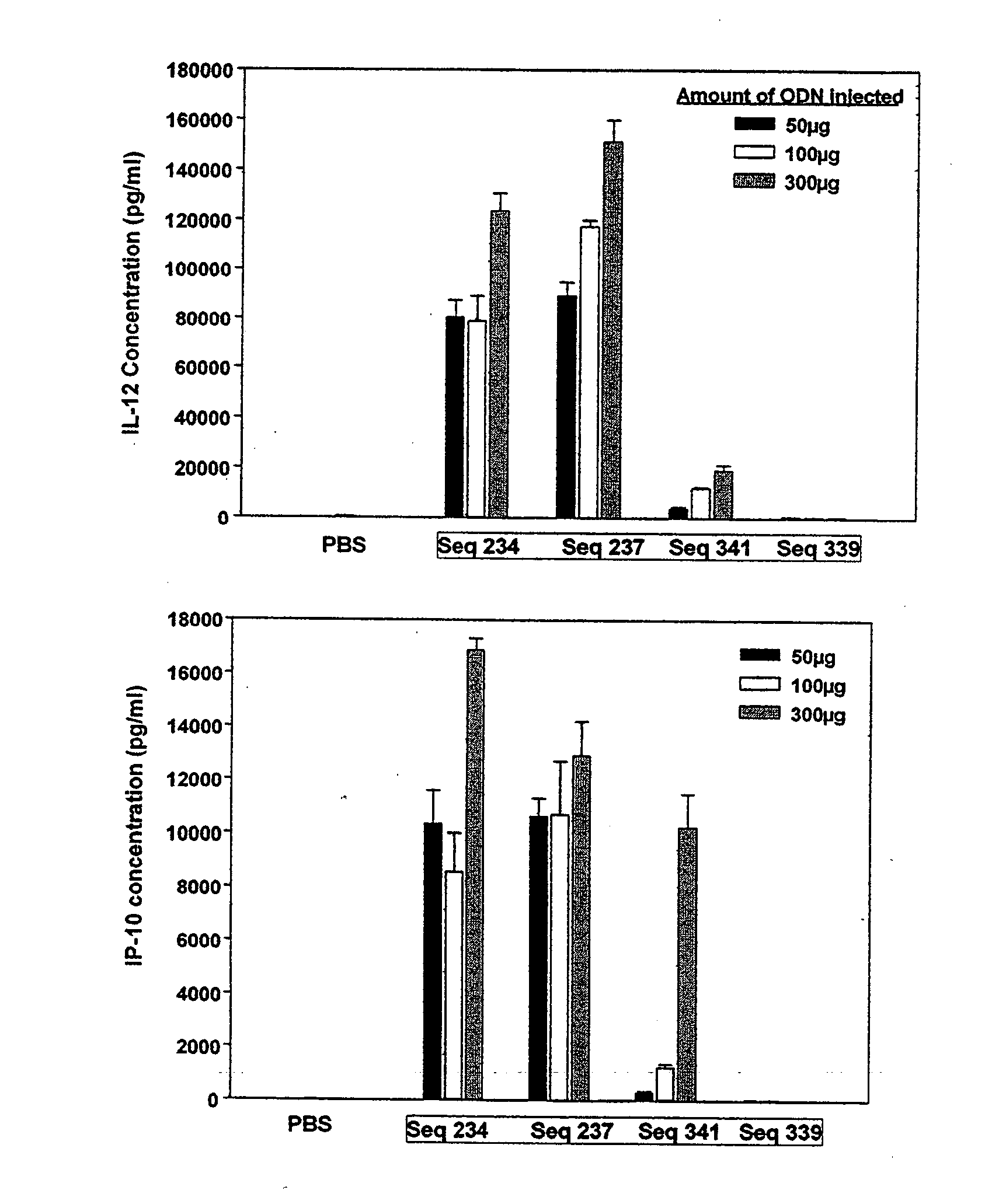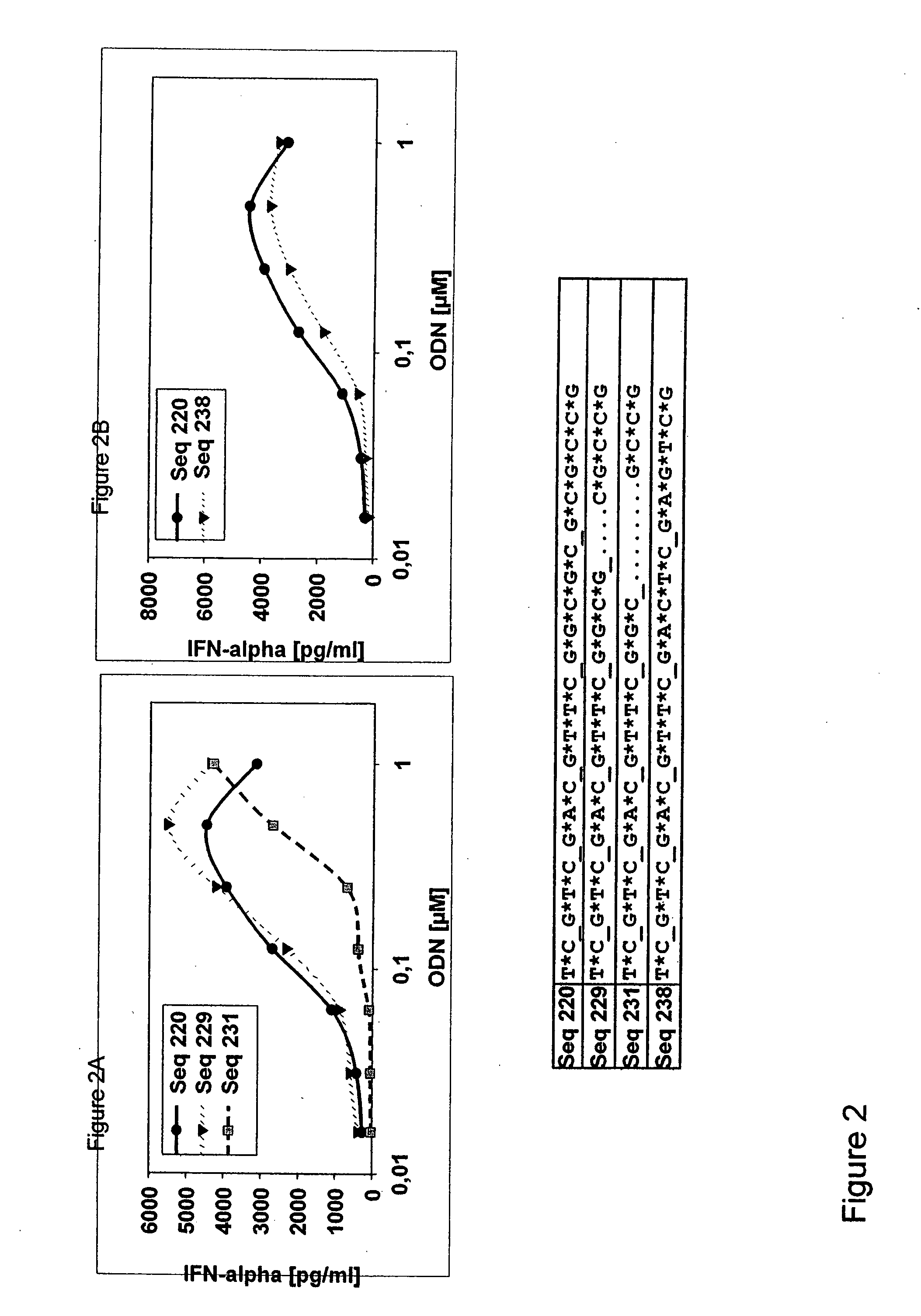Compositions and methods for oligonucleotide formulations
a technology of oligonucleotide and formulation, applied in the field of immunosuppressive nucleic acids, to achieve the effect of promoting nk cell activation and provoking ifn- secretion
- Summary
- Abstract
- Description
- Claims
- Application Information
AI Technical Summary
Benefits of technology
Problems solved by technology
Method used
Image
Examples
example 1
Induction of IFN-α by P-Class (Double-Palindromic) CpG Oligonucleotides in Human PBMC
[0223] Double-palindromic ODN were observed to be more potent IFN-α inducers than C-Class ODN in the studies performed. FIG. 1 shows graphs illustrating the induction of IFN-α with various ODN, including B-, C-, and P-Class as well as non-CpG controls. In the P-Class ODN in some cases the 5′ bases were part of the palindromic region, as in SEQ ID NO:234; however the 5′ base or bases did not have to be part of the 5′ palindromic region, as in SEQ ID NO:220. The ODN retained activity when the spacer between palindromes was as short as 1 nucleotide. For example, the spacer in SEQ ID NO:234 is ‘T’. D-Spacers and non-nucleotide spacers were also effective.
[0224] The ODN were most effective when the length of the 3′ palindromic region was at least 10 nucleotides. The 3′ palindrome could contain A / T base pairings and still be effective. FIG. 2 shows graphs illustrating the induction of IFN-α with various...
example 2
P-Class CpG ODN Induce Plasma Cytokine and Chemokine Production Superior to Conventional C-Classes
[0225] Conventional C-Class ODN such as SEQ ID NO:341 have been shown to stimulate Th1-like cytokine and chemokine responses in vivo in mice. Comparison of IL-12 and IP-10 production in plasma upon subcutaneous (SC) application revealed a dose-dependent IL-12 and IP-10 response for P-Class CpG ODN SEQ ID NOs:234 and 237 that was significantly higher compared to SEQ ID NO:341 (FIG. 4). Non-CpG control SEQ ID NO:339 did not induce any cytokine or chemokine production.
example 3
P-Class CpG ODN Stimulate Strongest IFN-α Production Upon In Vivo Administration
[0226] As demonstrated in Example 1, P-Class CpG ODN produced the highest IFN-a production upon stimulation of human PBMC when compared to other CpG ODN classes such as the C- and B-Classes. A similar observation was made when CpG ODN of different classes were injected in mice and IFN-α plasma levels were measured. Compared to the other classes (SEQ ID NO:344: A-Class; SEQ ID NOs:336, 347, 343: B-Class; SEQ ID NOs:346, 257: C-Class) P-Class ODN stimulated the strongest IFN-α production upon SC as well as intravenous (IV) administration (FIG. 5). Non-CpG control SEQ ID NO:339 did not induce any IFN-α production.
PUM
| Property | Measurement | Unit |
|---|---|---|
| Tm | aaaaa | aaaaa |
| Tm | aaaaa | aaaaa |
| length | aaaaa | aaaaa |
Abstract
Description
Claims
Application Information
 Login to View More
Login to View More - R&D
- Intellectual Property
- Life Sciences
- Materials
- Tech Scout
- Unparalleled Data Quality
- Higher Quality Content
- 60% Fewer Hallucinations
Browse by: Latest US Patents, China's latest patents, Technical Efficacy Thesaurus, Application Domain, Technology Topic, Popular Technical Reports.
© 2025 PatSnap. All rights reserved.Legal|Privacy policy|Modern Slavery Act Transparency Statement|Sitemap|About US| Contact US: help@patsnap.com



